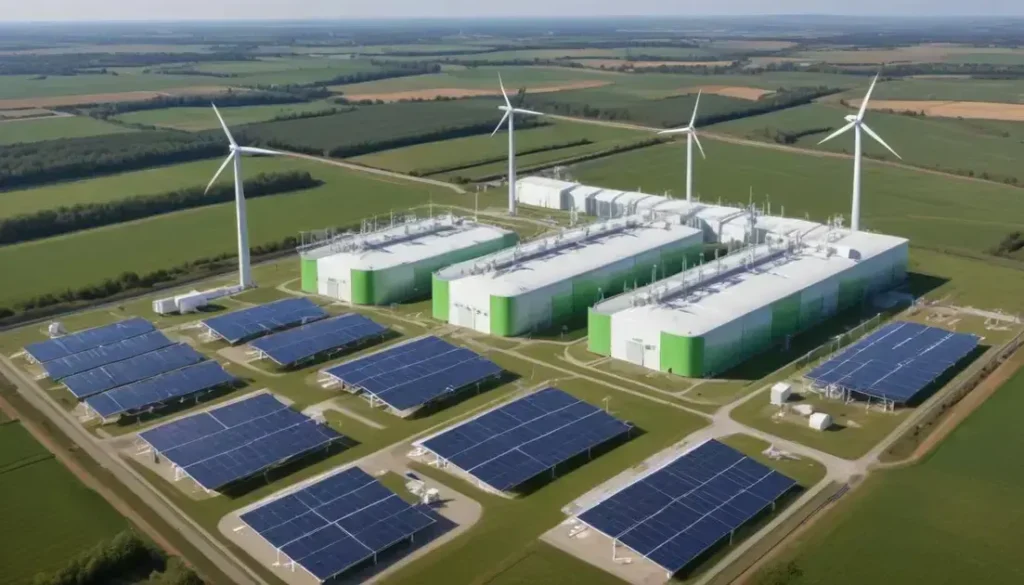Japan is committed to achieving carbon neutrality by 2050 through significant investments in renewable energy sources like solar, wind, and geothermal energy, aiming for 50% of its energy mix to come from renewables by 2030.
Renewable energy initiatives are gaining momentum worldwide, and Japan’s push towards sustainable practices, especially in Amazon’s new fulfillment center, highlights the *importance of renewable energy* for businesses. What does this mean for Indian firms?
Introduction to Amazon’s new fulfillment center
Amazon’s new fulfillment center in Japan stands as a remarkable example of integrating sustainable technologies to enhance operational efficiency. This state-of-the-art facility utilizes geothermal heating and cooling systems, significantly reducing reliance on conventional energy sources. By opting for these renewable energy solutions, Amazon is not only meeting its corporate sustainability goals but also setting a benchmark for others in the industry.
Additionally, the incorporation of solar energy systems enables the center to harness the abundant sunlight Japan receives. It is projected that the solar panels will generate a significant portion of the energy needed for daily operations. This shift is crucial for businesses looking to reduce their carbon footprint and comply with increasingly stringent environmental regulations.
The fulfillment center’s strategic location also plays a vital role in optimizing supply chain logistics. By situating itself close to major transport routes, it ensures faster delivery times, enhancing customer satisfaction. This focus on efficiency, paired with a commitment to sustainability, exemplifies how companies can balance profitability with ecological responsibility.
As global demand for green solutions grows, other businesses, especially in India, must take note. Adapting similar practices can enhance their market competitiveness while contributing positively to global sustainability efforts.
Location and significance of the fulfillment center
The location of Amazon’s new fulfillment center is strategically chosen to optimize logistical efficiency. Nestled near major transport hubs, this facility allows for swift distribution of products across Japan and beyond. Proximity to key highways and ports ensures that goods can be delivered promptly to customers, which is essential in today’s fast-paced e-commerce environment.
Significance of Location: By situating the center in a region with robust infrastructure, Amazon significantly cuts down on transportation costs while improving delivery times. This logistical advantage is crucial for maintaining a competitive edge in the crowded e-commerce market.
Furthermore, the region’s access to renewable energy sources, such as wind and solar, complements Amazon’s sustainability goals. Utilizing local energy helps in reducing overall operational carbon emissions, aligning the company’s objectives with environmental responsibility.
Additionally, the fulfillment center contributes to the local economy by creating job opportunities and fostering development in surrounding areas. This not only aids in building community relations but also enhances Amazon’s reputation as a responsible corporate entity.
Overall, the site’s strategic advantages make it a cornerstone in Amazon’s mission to deliver exceptional service while adhering to sustainability principles. This model could inspire other businesses aiming to improve their operational frameworks.
Technologies employed for sustainability
The implementation of advanced technologies at Amazon’s new fulfillment center underscores the company’s commitment to sustainability. Key among these technologies is the geothermal heating and cooling system, which significantly reduces the carbon footprint of the facility. This innovative system harnesses the natural heat from the earth, enabling the center to maintain optimal temperatures without relying heavily on traditional energy sources.
An equally important feature is the integration of solar panels. These panels are designed to capture sunlight and convert it into energy, contributing to the center’s overall energy needs. This solar energy system plays a crucial role in minimizing energy costs while promoting environmental stewardship.
Additionally, Amazon is employing automated sorting and robotics technologies that enhance operational efficiency. These systems streamline the processing of orders, enabling faster deliveries and reducing energy consumption. This approach not only meets growing consumer demand but also aligns with sustainable practices.
Another significant aspect is the facility’s emphasis on waste management. By implementing comprehensive recycling programs, Amazon ensures that packaging materials and other waste are effectively managed, further supporting its goal of zero waste. The combination of these technologies positions Amazon as a leader in sustainable logistics, inspiring other businesses to adopt similar practices in pursuit of environmental responsibility.
Details on geothermal heating and cooling
Geothermal heating and cooling represent a groundbreaking approach to energy efficiency at Amazon’s new fulfillment center. This system harnesses the Earth’s natural heat, providing a sustainable way to regulate indoor temperatures throughout the year. By utilizing geothermal energy, the facility significantly reduces its reliance on conventional heating and cooling methods.
The process involves a network of pipes buried deep in the ground. These pipes circulate a fluid that absorbs heat from the Earth during colder months and releases it indoors, while in warmer months, the system reverses this process. This energy-efficient system not only lowers operational costs but also minimizes greenhouse gas emissions, aligning with Amazon’s commitment to sustainability.
Furthermore, the technology is designed for longevity and low maintenance, contributing to lower lifecycle costs. The initial investment in geothermal systems is quickly offset by long-term savings on energy bills. Additionally, this innovation demonstrates how large-scale operations can adopt renewable energy solutions to meet their environmental goals.
The integration of geothermal heating and cooling highlights Amazon’s leadership in sustainable practices, setting an example for other companies. By embracing such technologies, businesses can improve their energy efficiency while supporting the global movement towards greener operations.
Impact of geothermal energy on energy savings
The implementation of geothermal energy at Amazon’s fulfillment center has a profound impact on energy savings. This innovative heating and cooling system significantly reduces dependency on conventional energy sources, leading to notable financial benefits. By harnessing the Earth’s natural heat, the center can maintain comfortable temperatures at a fraction of the cost associated with traditional HVAC systems.
Studies indicate that geothermal systems can reduce energy consumption by as much as 30-60% compared to conventional systems. This translates to substantial savings on utility bills, enhancing the overall operational efficiency of the facility. Moreover, the reduced energy usage contributes to lower greenhouse gas emissions, aligning with Amazon’s sustainability goals.
The cost-effectiveness of geothermal energy extends beyond just monthly savings. While the initial installation might involve higher upfront costs, the long-term return on investment is significant. Facilities that utilize geothermal energy often experience lower maintenance costs and a longer lifespan for their heating and cooling systems, making it a financially sound choice.
In addition, by reducing energy consumption, the fulfillment center sets a positive example for other businesses aiming to adopt sustainable practices. As more companies recognize the benefits of geothermal energy, the broader impact on the environment and economy can be substantial, promoting a shift towards renewable energy solutions in various industries.
Overview of solar energy integration
The integration of solar energy at Amazon’s new fulfillment center is a significant step towards achieving sustainability goals. By harnessing the power of the sun, this facility is equipped with a substantial array of solar panels that convert sunlight into electricity. This renewable energy source plays a critical role in powering daily operations.
Solar energy systems provide numerous advantages, including reduced energy costs and lower carbon emissions. The facility’s solar panels are designed to generate a substantial portion of the energy required, significantly decreasing reliance on fossil fuels. This not only aids in cost-efficiency but also contributes to a cleaner environment.
Furthermore, the integration of solar energy helps mitigate energy price fluctuations. By producing their own energy, the fulfillment center enhances its resilience against rising electricity prices, ensuring long-term economic stability. Additionally, during peak sunlight hours, excess energy can be stored or redirected back to the grid, creating further opportunities for savings.
The operational flexibility provided by solar energy also aligns with Amazon’s commitment to sustainability practices. It sets a precedent for other companies to follow, showcasing that large-scale energy solutions can coexist with eco-friendly initiatives. As solar technology continues to advance, the potential for even greater energy efficiency and sustainability becomes increasingly attainable.
Projected energy generation from solar panels
The projected energy generation from the solar panels installed at Amazon’s fulfillment center is a game-changer for the facility’s overall energy efficiency. With a robust array of solar panels, the center anticipates generating a substantial amount of energy annually, significantly reducing its dependence on traditional energy sources.
Data shows that the solar panels can produce around 1.5 megawatts of electricity. This output is expected to cover a significant portion of the center’s energy needs, translating into thousands of dollars saved in energy costs each month. By using the sun’s energy, Amazon not only lowers operational expenses but also minimizes its environmental impact.
Moreover, the excess energy generated during peak sunlight hours can be fed back into the grid, creating additional savings opportunities and enhancing the grid’s stability. This approach aligns with Amazon’s long-term sustainability goals, emphasizing the importance of renewable energy sources in large-scale operations.
As solar technology continues to advance, further increases in energy efficiency and monthly output are anticipated. The center’s focus on solar energy exemplifies how innovative solutions can drive significant savings while promoting environmental responsibility. By setting such examples, Amazon encourages other businesses to invest in solar energy as a viable alternative for a sustainable future.
Amazon’s renewable energy projects in Japan
Amazon’s renewable energy projects in Japan exemplify the company’s commitment to sustainable practices. With substantial investments in green energy, Amazon aims to optimize its supply chain while significantly reducing its carbon footprint. In Japan, the focus has been primarily on solar and geothermal energy sources.
One of the key initiatives includes a large-scale solar farm that generates clean energy to power several of its facilities in the region. The solar panels installed are expected to produce a considerable amount of electricity, directly contributing to Amazon’s operational needs and minimizing reliance on non-renewable resources.
Additionally, the company is leveraging geothermal energy, particularly in its new fulfillment center, where advanced geothermal heating and cooling systems are integrated into the design. This technology not only lowers energy costs but also significantly cuts carbon emissions, aligning with Amazon’s global sustainability goals.
These projects not only emphasize Amazon’s commitment to environmental stewardship but also serve as a blueprint for other corporations aiming to reduce their impact on the environment. By investing in renewable energy initiatives, Amazon positions itself as a leader in the transition to a low-carbon economy, encouraging other businesses in Japan and beyond to follow suit.
Collaborations with the Japanese government
Amazon’s collaborations with the Japanese government emphasize the company’s commitment to enhancing sustainability efforts within the region. These partnerships focus on integrating renewable energy solutions into various sectors, with particular attention on e-commerce and logistics.
Working closely with local authorities, Amazon has engaged in initiatives aimed at improving infrastructure while promoting green technologies. One notable aspect of these collaborations is the shared goal of achieving net-zero carbon emissions by 2050, aligning Amazon’s operational objectives with Japan’s national energy strategy.
Through these collaborations, Amazon has also invested in research and development of clean energy technologies, supporting innovative projects that can enhance energy efficiency across its operations. This commitment not only supports the local economy but also positions Japan as a leader in renewable energy initiatives.
The partnership extends to participating in government-led sustainability programs, which aim to educate and engage the community in green practices. By collaborating with the Japanese government, Amazon showcases its proactive approach to corporate social responsibility, encouraging other corporations to adopt similar sustainable practices.
Overall, these collaborations highlight a synergistic relationship that benefits both Amazon and Japan, fostering a more sustainable future through shared resources and innovative solutions.
Future goals for renewable energy in Japan
The future goals for renewable energy in Japan reflect a robust commitment to sustainability and environmental responsibility. Japan aims to achieve a carbon-neutral society by 2050, with significant investments in renewable energy technologies, particularly solar, wind, and geothermal energy. This ambitious vision aligns with global efforts to combat climate change.
One of the key objectives is to increase the share of renewables in the overall energy mix to 50% by 2030. To achieve this, Japan is focusing on enhancing infrastructure and implementing supportive policies that encourage the adoption of clean energy solutions. Solar energy projects are expected to play a pivotal role, given Japan’s geographical advantage for solar power generation.
Additionally, the government is promoting research and development in energy storage technologies, which are critical for balancing supply and demand in renewable energy systems. Innovations in battery technologies will enhance the reliability of renewable sources, enabling a more stable energy supply.
Moreover, Japan is looking to expand its international partnerships to foster knowledge sharing and technology transfer in the renewable sector. Collaborations with countries leading in renewable technologies can accelerate Japan’s transition to a sustainable energy economy. Overall, these goals emphasize Japan’s proactive approach to securing a sustainable future powered by renewable energy.
Challenges in Japan’s renewable energy sector
Japan’s renewable energy sector faces several significant challenges that hinder its growth and development. One of the primary issues is the limited land availability for large-scale solar and wind farms. Given Japan’s dense population and mountainous terrain, finding suitable locations for renewable installations can be difficult, which affects energy generation capacity.
Additionally, the lack of sufficient energy storage technologies complicates the situation. As renewable energy sources like solar and wind are intermittent, effective storage solutions are essential to ensure a stable energy supply. Without advanced battery systems, excess energy generated during peak times may go unused.
Another challenge is the regulatory framework surrounding renewable energy. Although Japan has made progress, the bureaucratic processes can be slow and cumbersome. Streamlining these regulations is crucial for accelerating the deployment of renewable energy projects.
Furthermore, public perception and acceptance play a vital role in the expansion of renewable energy. There is still some skepticism regarding the perceived reliability and safety of new energy technologies. To overcome these challenges, increased public awareness and education initiatives are needed to foster a positive attitude towards sustainable energy solutions.
Addressing these challenges is essential for Japan to realize its renewable energy goals and achieve a more sustainable future.
Conclusion on sustainability efforts
Japan’s sustainability efforts reflect a comprehensive approach to achieving a balance between economic growth and environmental stewardship. The government, alongside various private corporations, including Amazon, is committed to enhancing renewable energy adoption while minimizing carbon footprints. These initiatives pave the way for a greener future, fostering innovation in solar, wind, and geothermal energy.
To showcase their commitment, Japan aims for substantial reductions in greenhouse gas emissions by significantly increasing the share of renewables in their energy mix. This shift is not only pivotal for energy security but also crucial in combating the ongoing climate crisis.
Public awareness and community engagement are essential components of these sustainability efforts. By educating citizens about the benefits of renewable energy and implementing visible projects, stakeholders can foster a culture of sustainability. Involving local communities in planning and decision-making processes ensures a more inclusive approach to environmental initiatives.
As Japan continues to navigate its path towards sustainability, the lessons learned from current challenges will shape future strategies. Collaboration between government, businesses, and the public is vital to overcoming barriers and achieving overarching sustainability goals, creating a model for other nations to follow.
In conclusion, the path to a sustainable future
Japan’s efforts in renewable energy and sustainability demonstrate a strong commitment to protecting the environment while promoting economic growth. By investing in solar, wind, and geothermal technologies, Japan is paving the way for a greener economy.
Collaboration between the government, businesses, and communities plays a crucial role in achieving these ambitious goals. As citizens become more involved and aware of the benefits of renewable energy, the transition towards sustainability will gain momentum.
Despite the challenges faced, the opportunities for innovation and progress in clean energy are immense. Japan stands as an example of how a nation can embrace renewable solutions and serve as a model for others around the world.
By continuing to push for improvements in energy efficiency and fostering partnerships, Japan can lead the way towards a sustainable future for generations to come.
Commonly Asked Questions
What is Japan’s target for renewable energy by 2030?
Japan aims to increase the share of renewable energy in its overall energy mix to 50% by 2030.
How does Japan plan to achieve carbon neutrality by 2050?
Japan plans to achieve carbon neutrality by investing in renewable energy technologies and enhancing energy efficiency across various sectors.
What are the main renewable energy sources being developed in Japan?
Japan is focusing primarily on solar, wind, and geothermal energy sources to promote sustainability.
What challenges does Japan face in expanding renewable energy?
Challenges include limited land availability for renewable installations, insufficient energy storage technologies, and regulatory hurdles.
How important is public awareness for Japan’s sustainability efforts?
Public awareness is crucial as it encourages community involvement and support for renewable energy initiatives, making transitions smoother.
What role do collaborations with the government play in sustainability?
Collaborations with the government help streamline regulations, provide funding, and foster innovation in renewable energy projects.


